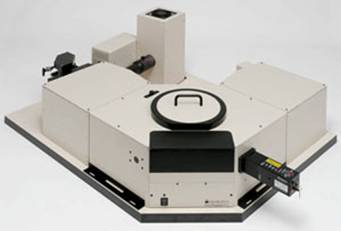Fluorescence lifetime and steady-state spectrometer
FLSP 920, Edinburgh Instruments
Technical characteristics:
Fluorescence lifetime and steady-state spectrometer (FLSP 920) is a suite of combined steady state and time resolved luminescence (fluorescence and phosphorescence spectrometers fabricated by Edinburgh Instruments.
All instruments of the FLSP 920 series (Fluorescence Lifetime Steady-state Phosphorescence) are based on a modular construction, enabling systems to be flexibly configured to meet your individual research needs, with almost any combination of accessories, detectors or excitation sources available from Edinburgh Instruments.
The steady state mode uses single photon counting whilst lifetime measurements are based on Time Correlated Single Photon Counting: the technique widely accepted to be the method of choice for maximum sensitivity, dynamic range, accuracy and precision. The sensitivity of the system guarantees a signal to noise ratio of 6000:1 for water Raman spectrum measured with excitation at 350 nm, emission at 397 nm, with a 1 second integration time and 5 nm spectral bandwidth. |
|
Description
Characteristics:
Lifetime ranges 10 ps - 10 s
UV - Vis - NIR spectral range
Single Photon Counting sensitivity
System:
Optical Configuration Right angle geometry (standard)
Additional geometries are available for
non-standard applications
Sensitivity:
Water Raman Spectrum Excitation wavelength = 350nm
Spectral bandwidth 5nm, integration time 1s
Peak Counts > 750,000cps @ 397nm
RMS Noise < 125cps @ 450nm
Signal to Noise Ratio > 6000:1
Excitation Source:
Type Continuous Xenon Arc Lamp
Lamp 450W, ozone free
Spectral Range 230 – 2600nm
Adjustment XYZ, focussing, rear mirror
Depth of Focus 150mm to ∞
Option ozone generating lamp with spectral range 200-2600nm
Monochromator:
Type Czerny-Turner
Focal Length 300mm
Gratings mounted to triple grating turret, fully computer controlled
Slits <10μm to 10mm, fully computer controlled
Stray Light Rejection 1:105 (1:1010 for double monochromators)
Options Double Grating Monochromator
********************** |
Grating:
Type Plane holographic or ruled grating
Standard 250/500nm blaze, 1800 grooves/mm
Dispersion 1.8 nm/mm
Resolution 0.05 – 18 nm
Wavelength Accuracy ± 0.2 nm
Wavelength Repeatability ± 0.1 nm
Minimum Step Size 0.05 nm
Options A variety of gratings with 300-2400grooves/mm,
optimised from VUV to NIR are available
Detector:
Photomultiplier Blue Sensitive Red Sensitive
Spectral Range 185 – 680 nm 185 – 870 nm
Window Material UV Glass UV Glass
Dark Count Rate (+24ºC) < 100 cps < 2000 cps
Dark Count Rate (-25ºC) < 5 cps < 50 cps
Options To allow NIR measurements, photomultipliers and analogue detectors are available
Data Acquisition:
Photon Counting Scalar Card Model PCS900 Plug-in PC Card
Mode of Operation Single photon counting / multi-channel scaling
Maximum Count Rate 100MHz
Computer Interface PCI
Software:
Operating System Windows®
Data Manipulation Mathematical, Smoothing, Integration,
Differentiation, 2-D and 3-D graphics, Contour Plot.
********************** |
Applications:
Applications in the broad areas of photophysics, photochemistry, biophysics and semiconductor study.
Complex intermolecular interactions can be revealed by lifetime measurements made across an emission spectrum which has little structure.
The scope for applications of fluorescence lifetime measurements is large and growing, from single molecule detection to lanthanide tracing; from singlet oxygen monitoring in photodynamic therapy to the study of new C-60 “fullerenes”; from Tryptophan protein studies to the characterisation of rare earth doped glasses; also the kinetic information given in fluorescence lifetime measurements opens the door to a greater level of understanding in: Time resolved polarisation measurements reveal the rotation rates of the emitting molecules and have many applications in structure determination, membrane fluidity, polymer dynamics and protein engineering.
Biomedical field: study of enzymes, dynamics and structure of nucleic acids, protein folding and DNA sequencing, use a-priori fluorescence lifetime knowledge of the fluorescent probe to characterise various systems.
Materials physics: study semiconductors and novel structures such as quantum wells and quantum dots or for the quality control monitoring in a wafer foundry, to characterise the doping or impurity level present.
Pharmaceutical sector: for monitoring drug interactions by studying the energy transfer mechanisms using fluorescence lifetimes as the indicator.
|
|
HOME |
 |
Last update: March 5, 2012 |
|


